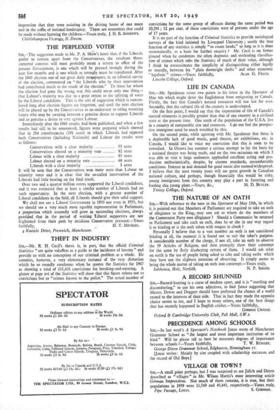THE COST OF NEW SCHOOLS
SIR,—In laying the foundation-stone of the first of the new secondary modern schools in Devonshire, the former chairman of the County Council observed: "If by the time the schools are built you have any money left in your pockets I shall be surprised." There are 35 such school: to be dealt with in the county, as well as 25 grammar and 500 primary schools. This first new modern school, which will accommodate 450, requires a minimum of 17 acres, and will cost £130,000. In addition to the initial cost, the waste of good farm land and the heavy cost of main- tenance ought surely to be reconsidered. By the 1944 Act each primary school must have a site of an acre and a further acre of playing field. Why ? Extensive grounds are out of place in the country, and only serve to make it look like suburbia. A playing field is of little use to children of 11 and under, as present experience shows ; it is quite sufficient to pay a small sum for the use of an adjoining field when required. If the Act is fully implemented it seems that 3,020 acres in this county must be lost to agriculture.
The one primary school already open in the county is so designed as to consume, for 80 children, 50 tons of coke a year. (Our own old-type school for a similar number burns only five tons.) The electric equip- ment in the canteen is said to take as much current as the entire village of 800. The extensive grounds require a full-time groundsman-cleaner at £4 19s. a week. The laying of a foundation- stone of a new school ought to be an occasion of rejoicing and con- gratulation, but on this occasion the principal speakers seemed chiefly concerned to apologise for the expenditure of land and money, and gave the
impression that they were assisting in the driving home of one -more nail in the coffin of national bankruptcy. There are economies that could be made without harming the children.—Yours truly, J. H. E. ANDREWS. Chit tlehampton Vicarage, N. Devon.











































 Previous page
Previous page